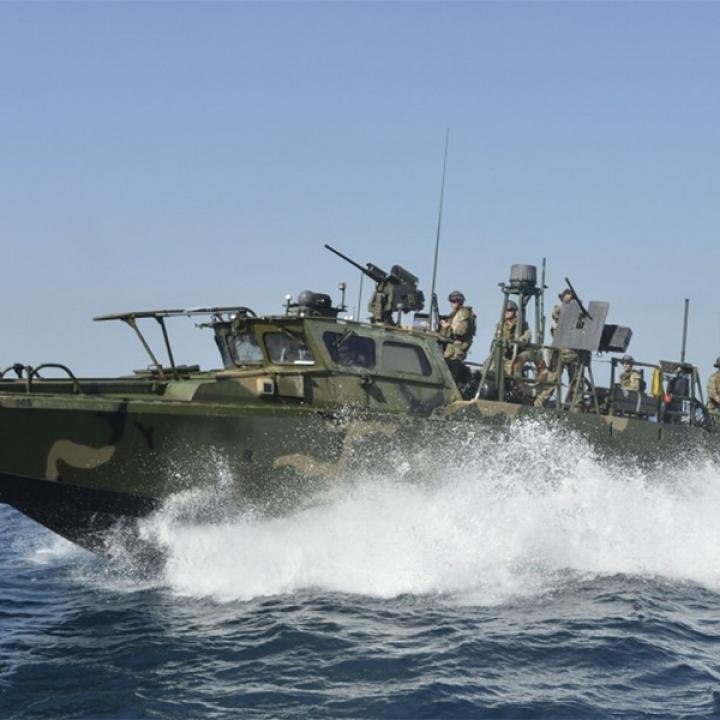
- Policy Analysis
- Policy Alert
Iran Once Again Captures Western Sailors in the Persian Gulf

Washington and Tehran must act now to prevent further escalation between their respective naval forces.
On the afternoon of January 12, Islamic Revolutionary Guard Corps (IRGC) patrol vessels seized ten U.S. Navy riverine squadron personnel near Iran's Farsi Island in the northern Persian Gulf. Iran claimed the U.S. vessels had strayed into Iranian waters. For its part, Iran enforces a twelve-mile buffer around the islands, a limit generally observed but not officially recognized by the U.S. Navy.
The sailors were traveling in two forty-nine-foot CB-90 shallow-water command craft armed with light machine guns. Reportedly on a training mission en route from Kuwait to Bahrain, the base of the Navy's Fifth Fleet, the sailors were taken to the island for interrogation and then released relatively quickly, along with their equipment, after intense diplomatic activity. Despite the sailors' release, the IRGC symbolism was inescapable.
The small Farsi Island, meanwhile, has been an important IRGC base, situated amid prominent Gulf shipping lanes, ever since the mid-1980s, when IRGC gunboats used it to stage attacks against international shipping. On July 24, 1987, while sailing thirteen miles west of Farsi, the U.S.-reflagged Kuwaiti tanker SS Bridgeton hit a sea mine planted by the IRGC Navy's second district, the same outfit that captured the U.S. sailors earlier this week. To counter such mining activities, the U.S. Navy placed a modified barge, the MSB Hercules, west of the island in October 1987. Two days later, armed Iranian boats were poised to attack the barge and ambush its helicopters, but they were preempted by Navy SEALs and Army Special Operations forces and the Iranians suffered ten casualties and lost two boats in the subsequent clashes. In turn, Iran accused the U.S. Navy of torturing Iranian prisoners. To this day, the Islamic Republic resents losing the last phase of the Tanker War due to an increased U.S. Special Operations presence in the northern Gulf. In such a broad context, Tuesday's event -- as well as other similar episodes -- can help lift IRGC morale amid continuous casualties in Syria and remind Iran's Islamic hardliners how much the country's capabilities have evolved since those earlier clashes.
The IRGC Navy's capture of U.S. troops marked the second time in a two-week period that it had made news by acting aggressively in the Persian Gulf. On December 29, a pack of IRGC gunboats fired 107-millimeter Falaq rockets at imaginary targets when shadowing the USS Harry S. Truman, which was transiting the busy Strait of Hormuz just 1,500 yards away. Although the incident was captured on U.S. thermal cameras, the IRGC denied any involvement. The message, however, had already been loudly sent, and it followed a known asymmetric objective of going after high-value targets. In both incidents, Iran signaled to the U.S. military that it holds America's finest at risk and is prepared to take action to defend its regional interests.
Just yesterday, Maj. Gen. Hassan Firouzabadi, who chairs the general staff of the Iranian armed forces, warned the U.S. Congress against any measures that could jeopardize JCPOA implementation, and advised its members to take this latest episode as a lesson.
As regards Iran's internal dynamics, President Hassan Rouhani's government may have worked hard to secure the release of U.S. service members quickly, but Iranian hardliners made sure the sailors were not freed before President Obama's State of the Union address, with the aim of maximizing the humiliating effect.
These recent incidents show that dominant hardliners, as directed by Supreme Leader Ali Khamenei, are eager to retaliate against what they believe is U.S. meddling in Iran's own internal affairs and to influence U.S. domestic affairs whenever possible. Therefore, one would not be surprised, for example, if IRGC Navy commander Ali Fadavi tried to link the recent fall in U.S. stock markets to the Gulf incident.
The IRGC is first and foremost a Shiite religious body, created to counterbalance the still-secular national armed forces and to safeguard the Islamic Revolution. It has its own ground, naval, and air forces and obeys velayat-e faqih -- the doctrine granting the Supreme Leader his authority -- without question. As it happens, the naval branch is among the IRGC's most zealous. The mere fact that incidents such as the one this week almost always occur in the Persian Gulf and Strait of Hormuz, where the IRGC has jurisdiction, might suggest a more professional and coolheaded approach by the other Iranian navy -- the national navy -- which operates in the deeper waters of the Gulf of Oman and Arabian Sea.
While Iran's two separate navies use different tactics and equipment, executive decisions on matters as vital as capturing foreign military or civilian vessels, or closing the Strait of Hormuz, are made directly by the Supreme Leader, as reiterated by Firouzabadi, with the National Security Council only advising him.
Following the rocket firings, personnel seizures, and circulation of humiliating images of disarmed U.S. sailors with their hands behind their heads, tensions are high between the U.S. and IRGC naval forces. To prevent further escalation, the two countries must act wisely. Although Iran has once rebuffed the idea of establishing a hotline with the U.S. Navy for exactly such circumstances, maybe now is the time to reconsider this option.
Farzin Nadimi is a Washington-based analyst specializing in the security and defense affairs of Iran and the Persian Gulf region.


